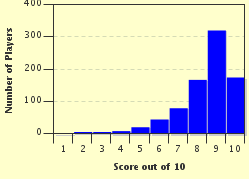Quiz Answer Key and Fun Facts
1. The most popular version of this beautiful old love song is from the 1930 movie "The Vagabond King" starring Jeanette MacDonald and Dennis King. Can you name it?
2. Based on an Irish air, the words to this old Irish patriotic song were written by the Irish poet and singer Thomas Moore approximately 1800. Can you work out its name from the pictured clue?
3. This traditional Welsh folk song has been around for a long time, but was first published in 1802. Can you work out its name from the photo clue?
4. This song was originally written and recorded in Zulu in the 1920s, but made popular on the charts in English during the 1960s by the Tokens. Which of the following is it?
5. "The Banks of Doon" is a song that was written in 1791 by the famous Scot, Robbie Burns. It is more familiar to most by another title. Can you name it by looking at the pictured clue?
6. First written in 1898, this beautiful number has been recorded by artists on and off ever since. Can you work out its name from the accompanying photo?
7. This beautiful aria is taken from the opera "The Bohemian Girl" by Michael William Balfe. Can you work out its name from the pictured clue?
8. This lovely song was written and recorded by John Denver about his wife Annie when, sadly, they were in the process of being divorced. It was also recorded as a duet with the great tenor, Placido Domingo. Can you name it?
9. Known as "The Anniversary Song" when Al Jolson recorded it in 1946, this lovely song was based on a Romanian waltz written in 1880. Looking at the pictured clue should help with its original name. What is it?
10. The beautiful old ballad is based on an 1889 work by Irish poet William Butler Yeats. Can you work out its name from the photo clue given?
Source: Author
Creedy
This quiz was reviewed by FunTrivia editor
kyleisalive before going online.
Any errors found in FunTrivia content are routinely corrected through our feedback system.

